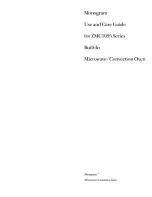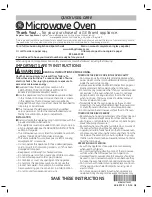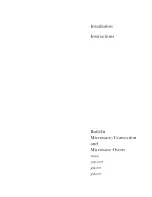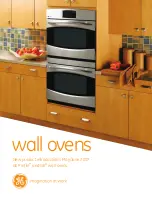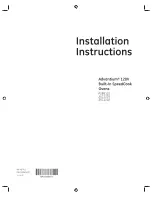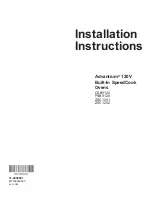
Tested for you in our cooking studio
en
67
Recommended setting values
In the table, you can find settings for drying various
foodstuffs. The temperature and cooking time are
dependent on the type, moisture, ripeness and
thickness of the food to be dried. The longer you leave
the food to be dried, the better it will be preserved. The
thinner the slices are, the quicker the drying process
will be and the more aromatic the dried food will
remain. Setting ranges are indicated for this reason.
If you wish to dry additional foodstuffs, you should use
similar foodstuffs in the table as a reference.
Type of heating used:
■
&
Drying
Preserving
You can preserve fruit and vegetables using your
appliance.
:
Warning – Risk of injury!
If the food is preserved incorrectly, the preserving jars
may burst. Follow the instructions for preserving.
Jars
Use only clean and undamaged preserving jars. Only
use heat-resistant, clean and undamaged rubber rings.
Check clips and clamps in advance.
For each preserving process, only use preserving jars
that are the same size and contain the same food. In
the cooking compartment, you can preserve the
contents of a maximum of six
^
, 1 or 1
^
-litre
preserving jars at the same time. Do not use jars that
are larger or taller than this. The lids could rupture.
Preserving jars must not touch one another in the
cooking compartment during the preserving process.
Preparing fruit and vegetables
Only use fruit and vegetables that are in good condition.
Wash them thoroughly.
Peel, core and chop fruit and vegetables appropriate to
their type and fill the preserving jars with them up to
approx. 2 cm below the rim.
Fruit
Fill the preserving jars with the fruit along with a hot,
skimmed sugar solution (approx. 400 ml for a 1-litre
jar). For one litre of water:
■
Approx. 250 g sugar for sweet fruit
■
Approx. 500 g sugar for sour fruit
Vegetables
Fill the jars with the vegetables along with hot, boiled
water.
Wipe the rims of the jars, as they must be clean. Place
a damp rubber ring and a lid on each jar. Seal the jars
with clamps. Place the jars into the universal pan so
that they do not touch each other. Pour 500 ml hot
water (approx. 80 °C) into the universal pan. Use the
settings indicated in the table.
Ending the preserving process
Fruit
After a short while, small bubbles will form at short
intervals. Switch off the appliance once all preserving
jars are bubbling. Remove the jars from the cooking
compartment after the indicated cooling time.
Vegetables
After a short while, small bubbles will form at short
intervals. As soon as all preserving jars are bubbling,
reduce the temperature to 120 °C and allow the jars to
continue to bubble in the closed cooking compartment
as indicated in the table. After this time has elapsed,
switch off the appliance and make use of the residual
heat for several minutes as indicated in the table.
After preserving, remove the jars from the cooking
compartment and place them onto a clean cloth. Do not
place these hot jars onto a cold or damp surface, as
they may crack. Cover the preserving jars to protect
them from draughts. Only remove the clamps once the
jars are cold.
Dish
Accessories
Shelf posi-
tion
Type of
heating
Tempera-
ture in °C
Cooking
time in
hours
Pomes (apple rings, 3 mm thick, 200 g per
wire rack)
1-2 wire racks
-
&
80
3-6
Pomes (apple rings, 3 mm thick, 200 g per
wire rack)
3-4 wire racks
-
&
80
6-8
Stone fruit (plums)
1-2 wire racks
-
&
80
4-8
Stone fruit (plums)
3-4 wire racks
-
&
80
8-10
Root vegetables (carrots), grated, blanched
1-2 wire racks
-
&
80
6-8
Root vegetables (carrots), grated, blanched
3-4 wire racks
-
&
80
6-8
Sliced mushrooms
1-2 wire racks
-
&
60
4-7
Sliced mushrooms
3-4 wire racks
-
&
60
7-9
Herbs, washed
1-2 wire racks
-
&
60
1-3
Herbs, washed
3-4 wire racks
-
&
60
3-6
Содержание HNG6764.1A
Страница 1: ... en Instruction manual Oven with microwave and steam jet function HNG6764 1A ...
Страница 2: ......
Страница 75: ......
Страница 76: ...3PCFSU PTDI BVTHFSÉUF NC XXX CPTDI IPNF DPN BSM 8FSZ 4USB F ßODIFO 3 9001050407 9001050407 960503 ...

























